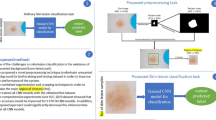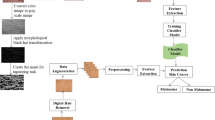Abstract
Automated annotation of skin biopsy histopathological images provides valuable information and supports for diagnosis, especially for the discrimination between malignant and benign lesions. Currently, computer-aid analysis of skin biopsy images mostly relied on some human-designed features, which requires expensive human efforts and experiences in problem domains. In this study, we propose an annotation framework for automated skin biopsy image analysis which makes use of a deep model for image feature representation. A convolutional neural network (CNN) is designed for local regions of skin biopsy images which learns potential high-level features automatically from input raw pixels. The annotation model is constructed in the multiple-instance multiple-label (MIML) learning framework with the features learned through the network. We achieve significant improvement of the model performance on a real world clinical skin biopsy image dataset and a benchmark dataset. Moreover, our study indicates that deep learning based model could achieve better performance than human designed features.










Similar content being viewed by others
References
Ali R, Gunduz-Demir C, Szilágyi T, Durkee B, Graves EE (2013) Semi-automatic segmentation of subcutaneous tumours from micro-computed tomography images. Phys Med Biol 58(22):8007
Angel CR, Juan CC, Fabio AG (2011) Visual pattern mining in histology image collections using bag of features. Journal Artificial Intelligence in Medicine 52(2011):91–106
Baldi A, Murace R, Dragonetti E, Manganaro M, Bizzi S (2014) Automated content-based image retrieval: Application on dermoscopic images of pigmented skin lesions. In: Skin Cancer. Springer, pp 523–528
Bengio Y (2009) Learning deep architectures for ai. Found Trends Mach Learn 2(1):1–127
Bengio Y (2013) Deep learning of representations: Looking forward. In: Proceedings of the 1st International Conference on Statistical Language and Speech Processing, Springer-Verlag, Berlin, Heidelberg, SLSP’13, pp 1–37
Bishop CM (2006) Pattern recognition and machine learning (information science and statistics). Springer-Verlag, Secaucus
Bunte K, Biehl M, Jonkman MF, Petkov N (2011) Learning effective color features for content based image retrieval in dermatology. Pattern Recogn 44(9):1892–1902
Caicedo JC, Cruz-Roa A, González FA (2009) Histopathology image classification using bag of features and kernel functions. In: Combi C, Shahar Y, Abu-Hanna A (eds) Proceedings of AIME, Lecture Notes in Computer Science, vol 5651, pp 126–135
Cerroni L, Argenyi Z, Cerio R, Facchetti F, Kittler H, Kutzner H, Requena L, Sangueza OP, Smoller B, Wechsler J, Kerl H (2010) Influence of evaluation of clinical pictures on the histopathologic diagnosis of inflammatory skin disorders. J Am Acad Dermatol 63(4):647–52
Chen J, Zhao F, Cao H (2013) Knowledge acquisition from generalized experts oriented to product innovation. In: 2013 6th international conference on Information management, innovation management and industrial engineering (ICIII), vol 2. IEEE, pp 546–549
Chen Y, Wang JZ (2004) Image categorization by learning and reasoning with regions. J Mach Learn Res 5:913–939
Cho Y (2012) Kernel methods for deep learning. PhD thesis, La Jolla, CA, USA, aAI3513249
Dietterich TG, Lathrop RH, Lozano-Pérez T (1997) Solving the multiple instance problem with axis-parallel rectangles. Artif Intell 89(1-2):31–71
Dong R (2011) Feature grouping technique to relax sample support requirement for sparse linear feature extraction. In: 2011 seventh international conference on Natural computation (ICNC), vol 3. IEEE, pp 1654–1657
Ferrara G, Argenyi Z, Argenziano G, Cerio R, Cerroni L, Di Blasi A, Feudale EA, Giorgio CM, Massone C, Nappi O, Tomasini C, Urso C, Zalaudek I, Kittler H, Soyer HP (2009) The influence of clinical information in the histopathologic diagnosis of melanocytic skin neoplasms. PLoS One 4(4):e5375
Foulds J, Frank E (2010) A review of multi-instance learning assumptions. Knowl Eng Rev 25(1):1–25
Gao L, Song J, Zou F, Zhang D, Shao J (2015) Scalable multimedia retrieval by deep learning hashing with relative similarity learning. In: Proceedings of the 23rd ACM International Conference on Multimedia, ACM, New York, NY, USA, MM ’15, pp 903–906
He J, Gu H, Wang Z (2012) Bayesian multi-instance multi-label learning using gaussian process prior. Mach Learn 88(1-2):273–295
Hinton GE, Salakhutdinov RR (2006) Reducing the dimensionality of data with neural networks. Science 313(5786):504–507
Hinton GE, Osindero S, Teh YW (2006) A fast learning algorithm for deep belief nets. Neural Comput 18(7):1527–54
Huang PS, He X, Gao J, Deng L, Acero A, Heck L (2013) Learning deep structured semantic models for web search using clickthrough data. In: Proceedings of the 22nd ACM International Conference on Conference on Information & Knowledge Management, ACM, New York, NY, USA, CIKM ’13, pp 2333–2338
Li Y, Su H, Qi CR, Fish N, Cohen-Or D, Guibas LJ (2015) Joint embeddings of shapes and images via cnn image purification. ACM Trans Graph 34(6):234:1–234:12
Lopes N, Ribeiro B (2014) Towards adaptive learning with improved convergence of deep belief networks on graphics processing units. Pattern Recogn 47(1):114–127
Malik MSA, Sulaiman S (2014) Dba’s perspective on use of information visualization in electronic health records
Marrugo AG, Millan MS (2011) Retinal image analysis: preprocessing and feature extraction. Journal of Physics: Conference Series, IOP Publishing 274:012039
Murthy VN, Maji S, Manmatha R (2015) Automatic image annotation using deep learning representations. In: Proceedings of the 5th ACM on International Conference on Multimedia Retrieval, ACM, New York, NY, USA, ICMR ’15, pp 603–606
Ooi BC, Tan KL, Wang S, Wang W, Cai Q, Chen G, Gao J, Luo Z, Tung AK, Wang Y, Xie Z, Zhang M, Zheng K (2015) Singa: A distributed deep learning platform. In: Proceedings of the 23rd ACM International Conference on Multimedia, ACM, New York, NY, USA, MM ’15, pp 685–688
Schapire RE, Singer Y (2000) Boostexter: a boosting-based system for text categorization. Mach Learn 39(2-3):135–168
Shi J, Malik J (2000) NorMalized cuts and image segmentation. IEEE Trans Pattern Anal Mach Intell 22(8):888–905
Stoean C, Stoean R, Sandita A, Mesina C, Gruia CL, Ciobanu D (2015) Evolutionary search for an accurate contour segmentation in histopathological images. In: Proceedings of the Companion Publication of the 2015 Annual Conference on Genetic and Evolutionary Computation, ACM, New York, NY, USA, GECCO Companion ’15, pp 1491–1492
Tang Y (2013) Deep learning using support vector machines. CoRR arXiv:1306.0239
Tipping ME (2001) Sparse bayesian learning and the relevance vector machine. J Mach Learn Res 1:211–244
Trinh HP, Duranton M, Paindavoine M (2015) Efficient data encoding for convolutional neural network application. ACM Trans Archit Code Optim 11(4):49:1–49:21
Vincent P, Larochelle H, Lajoie I, Bengio Y, Manzagol PA (2010) Stacked denoising autoencoders: Learning useful representations in a deep network with a local denoising criterion 11:3371–3408
Zhang G, Shu X, Liang Z, Liang Y, Chen S, Yin J (2012a) Multi-instance learning for skin biopsy image features recognition, Philadelphia, PA, United states, pp 83–88
Zhang G, Yin J, Li Z, Liang Z, Fu W (2012b) Deep learning for acupuncture point selection patterns based on veteran doctor experience of chinese medicine. In: Proceedings of the 2012 IEEE International Conference on Bioinformatics and Biomedicine Workshops (BIBMW), IEEE Computer Society, Washington, DC, USA, BIBMW ’12, pp 396–401
Zhang G, Yin J, Li Z, Su X, Li G, Zhang H (2013) Automated skin biopsy histopathological image annotation using multi-instance representation and learning. BMC Med Genet 6(3):1–14
Zhang G, Yin J, Su XY, Huang YJ, Lao YR, Liang ZH, Ou SX, Zhang HL (2014) Augmenting multi-instance multilabel learning with sparse bayesian models for skin biopsy image analysis. BioMed Research International 2014(Article ID 305629):13 pages
Zhang ML (2009) Generalized multi-instance learning: Problems, algorithms and data sets
Zhang S, Huang Q, Hua G, Jiang S, Gao W, Tian Q (2010) Building contextual visual vocabulary for large-scale image applications. In: Proceedings of the international conference on Multimedia. ACM, pp 501–510
Zhong R, Tezuka T (2014) Parametric learning of deep convolutional neural network. In: Proceedings of the 19th International Database Engineering & Applications Symposium, ACM, New York, NY, USA, IDEAS ’15, pp 226–227
Zhou ZH, Zhang ML, Huang SJ, Li YF (2012) Multi-instance multi-label learning. Artif Intell 176(1):2291–2320
Acknowledgements
This work is supported by National Natural Science Foundation of China (No. 61502106, 81373883, 81573827), Natural Science Foundation of GuangDong Province (No. 2016A030310340), the College Student Career and Innovation Training Plan Project of Guangdong Province (xj201511845018, yj201511845038, yj201611845074, yj201611845075, yj201611845366), the Special Fund of Cultivation of Technology Innovation for University Students (pdjh2016b0150), the 2015 Research Project of Guangdong Education Evaluation Association (No. G-11) and Fujian Major Project of Regional Industry (No. 2014H4015).
Author information
Authors and Affiliations
Corresponding author
Ethics declarations
Competing Interests
The authors declare that there is no conflict of interests regarding the publication of this article.
Rights and permissions
About this article
Cite this article
Zhang, G., Hsu, CH.R., Lai, H. et al. Deep learning based feature representation for automated skin histopathological image annotation. Multimed Tools Appl 77, 9849–9869 (2018). https://doi.org/10.1007/s11042-017-4788-5
Received:
Revised:
Accepted:
Published:
Issue Date:
DOI: https://doi.org/10.1007/s11042-017-4788-5




